Abstract
Sterigmatocystin (ST), a potent hepatocarcinogen, was covalently bound to calf thymus DNA by incubation in the presence of phenobarbital-induced rat liver microsomes. Acid hydrolysis of ST-modified DNA liberated a major guanine-containing adduct, present in DNA at an estimated level of 1 ST residue per 100-150 nucleotides. The adduct was isolated by high-pressure liquid chromatography and subjected to structural analysis. Spectral and chemical data identified the adduct as 1,2-dihydro-2-(N(7)-guanyl)-1-hydroxysterigmatocystin, the guanine and hydroxyl moieties being in a trans configuration. The structure and stereochemistry of this adduct indicated that the exo-ST-1,2-oxide was the metabolite that reacted with DNA, and the quantitative yield of adduct indicated that this metabolite was a major product of the in vitro metabolism of ST.
Full text
PDF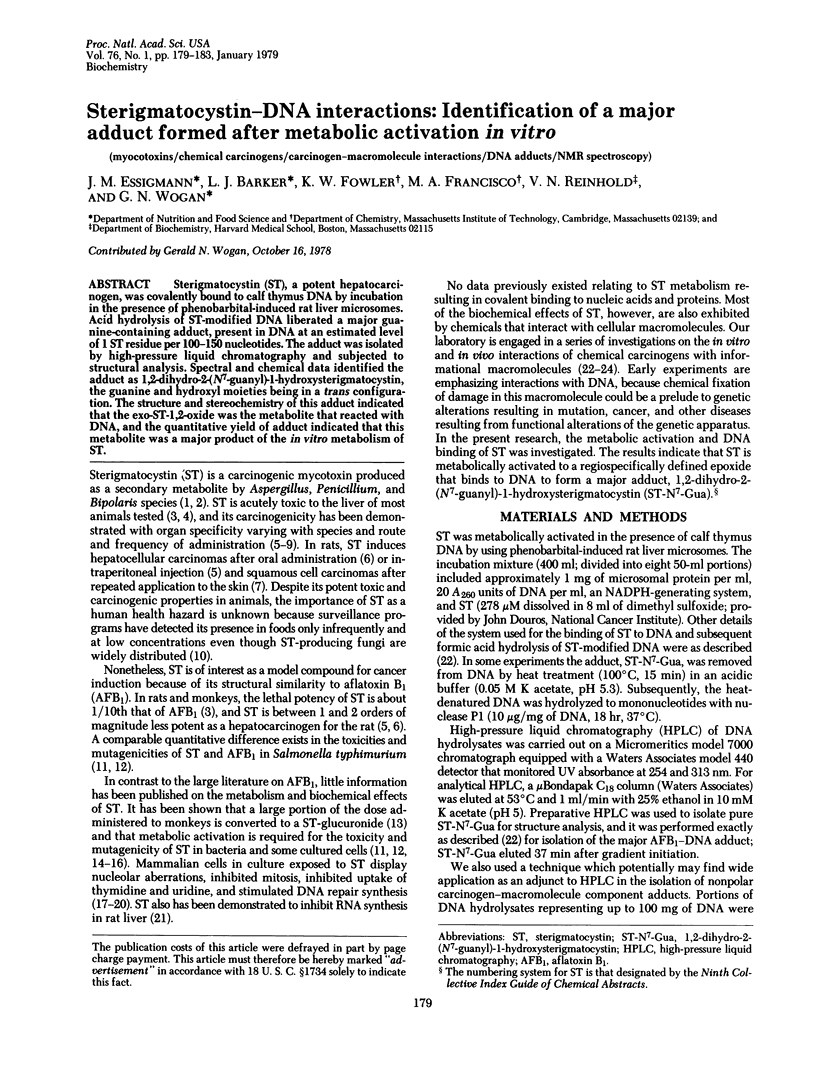
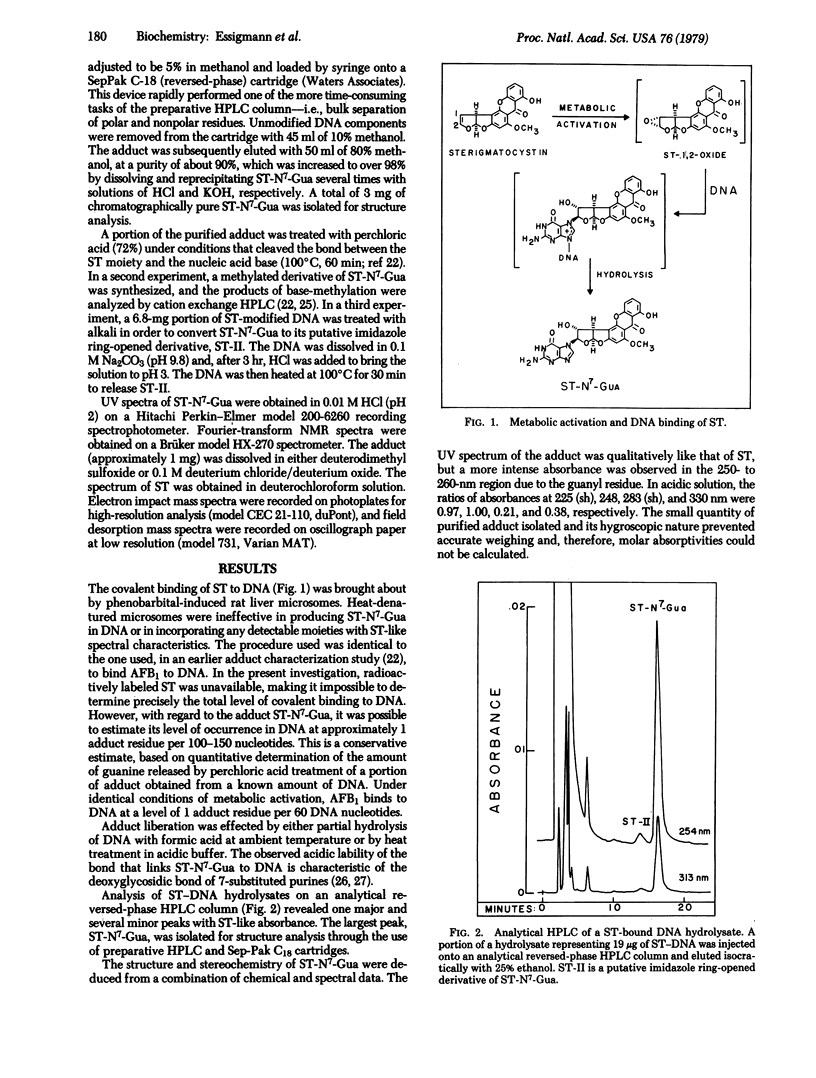
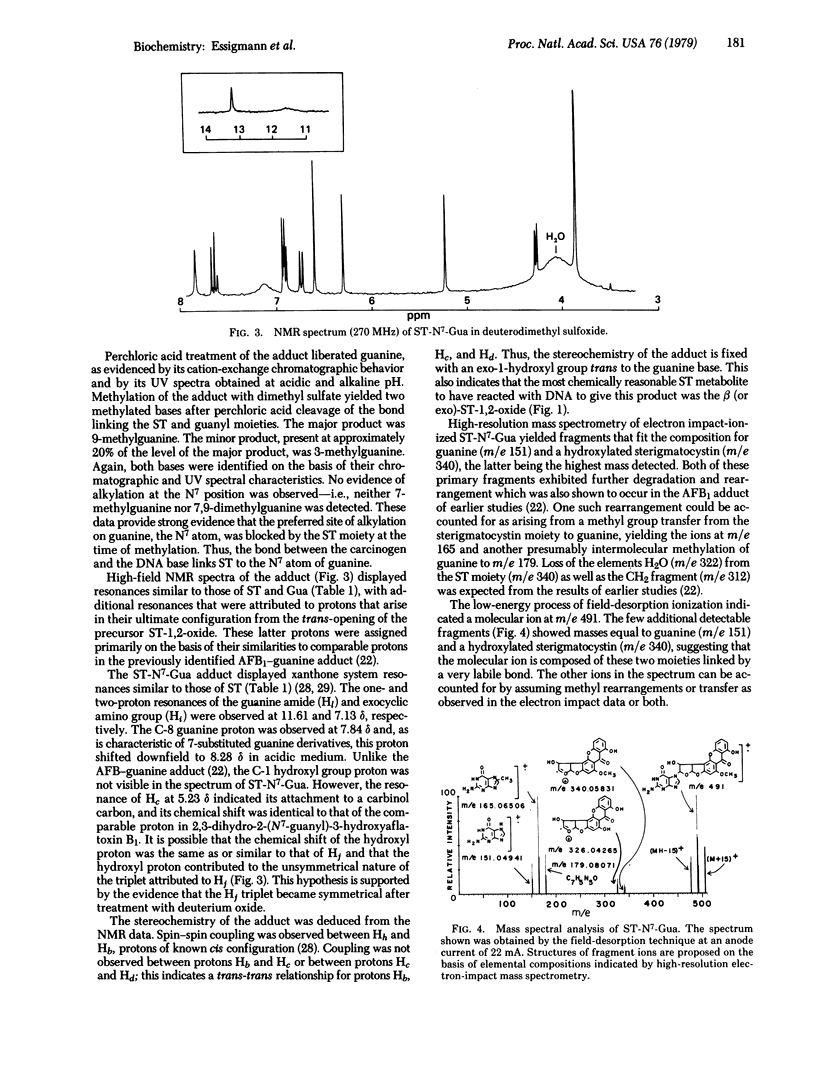
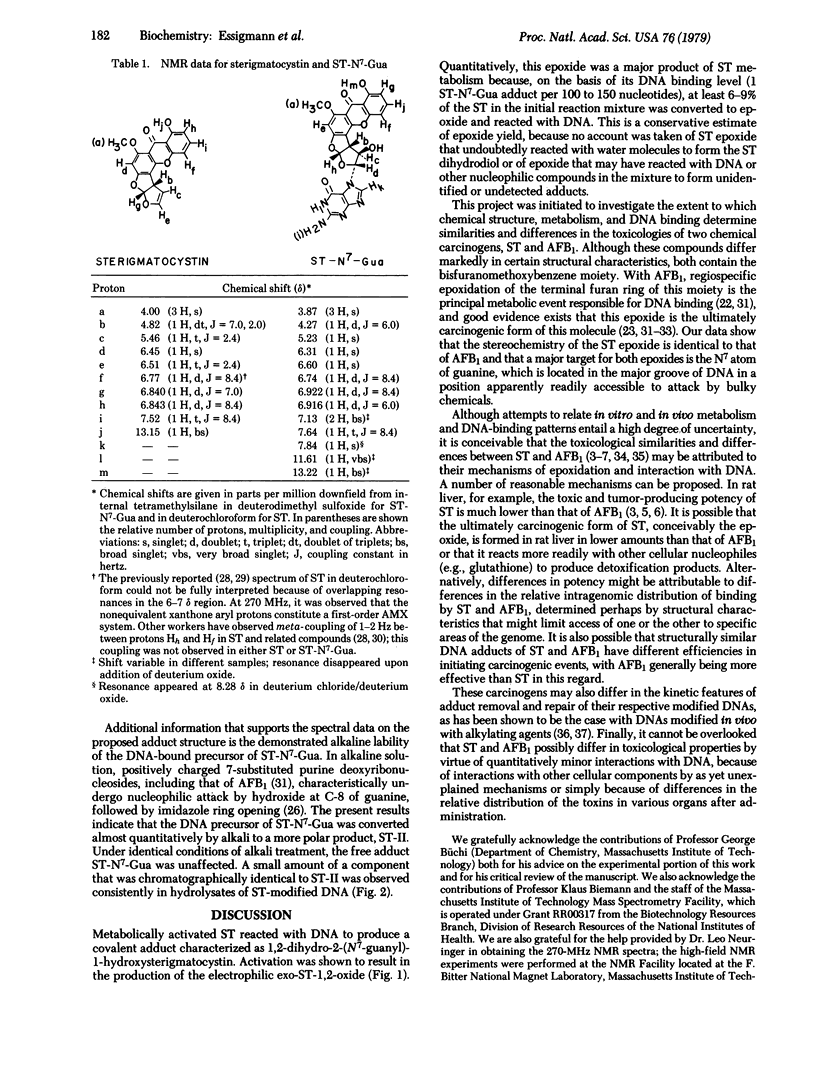
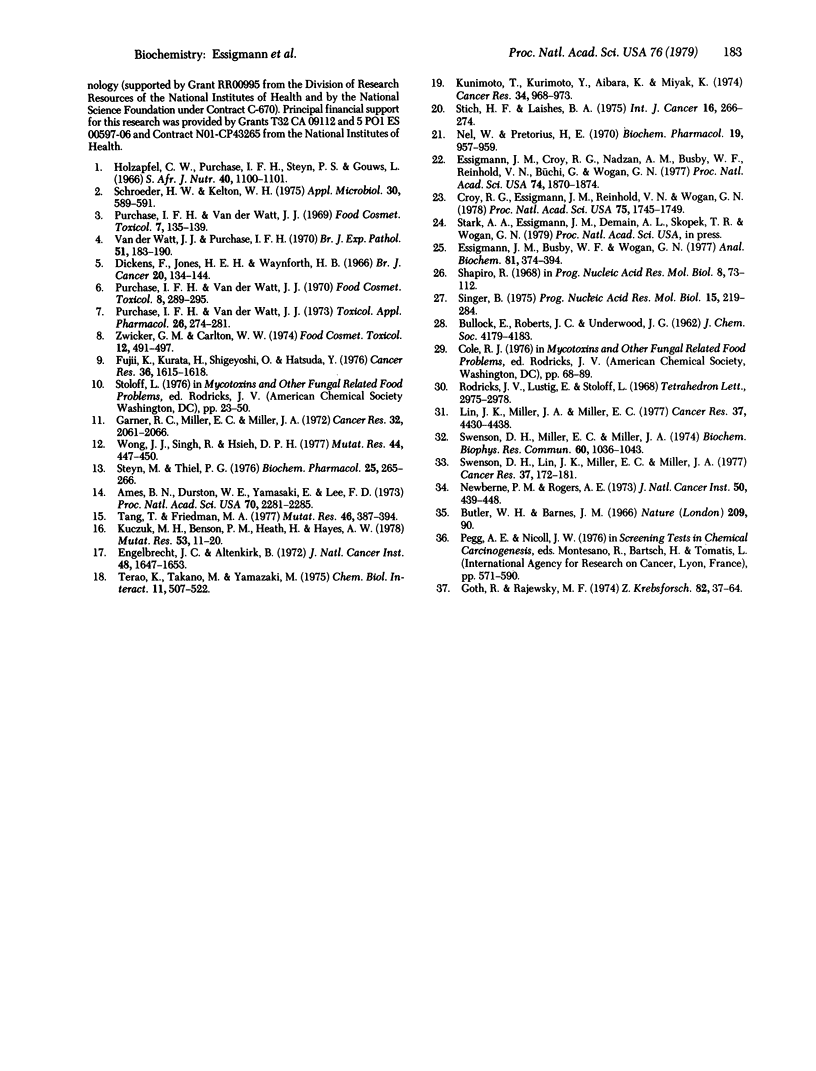
Selected References
These references are in PubMed. This may not be the complete list of references from this article.
- Ames B. N., Durston W. E., Yamasaki E., Lee F. D. Carcinogens are mutagens: a simple test system combining liver homogenates for activation and bacteria for detection. Proc Natl Acad Sci U S A. 1973 Aug;70(8):2281–2285. doi: 10.1073/pnas.70.8.2281. [DOI] [PMC free article] [PubMed] [Google Scholar]
- Butler W. H., Barnes J. M. Carcinoma of the glandular stomach in rats given diets containing aflatoxin. Nature. 1966 Jan 1;209(5018):90–90. doi: 10.1038/209090a0. [DOI] [PubMed] [Google Scholar]
- Croy R. G., Essigmann J. M., Reinhold V. N., Wogan G. N. Identification of the principal aflatoxin B1-DNA adduct formed in vivo in rat liver. Proc Natl Acad Sci U S A. 1978 Apr;75(4):1745–1749. doi: 10.1073/pnas.75.4.1745. [DOI] [PMC free article] [PubMed] [Google Scholar]
- Dickens F., Jones H. E., Waynforth H. B. Oral, subcutaneous and intratracheal administration of carcinogenic lactones and related substances: the intratracheal administration of cigarette tar in the rat. Br J Cancer. 1966 Mar;20(1):134–144. doi: 10.1038/bjc.1966.15. [DOI] [PMC free article] [PubMed] [Google Scholar]
- Engelbrecht J. C., Altenkirk B. Comparison of some biological effects of sterigmatocystin and aflatoxin analogues on primary cell cultures. J Natl Cancer Inst. 1972 Jun;48(6):1647–1655. [PubMed] [Google Scholar]
- Essigmann J. M., Busby W. F., Jr, Wogan G. N. Quantitative determination of transfer RNA base composition using high-pressure liquid chromatography. Anal Biochem. 1977 Aug;81(2):384–394. doi: 10.1016/0003-2697(77)90709-6. [DOI] [PubMed] [Google Scholar]
- Essigmann J. M., Croy R. G., Nadzan A. M., Busby W. F., Jr, Reinhold V. N., Büchi G., Wogan G. N. Structural identification of the major DNA adduct formed by aflatoxin B1 in vitro. Proc Natl Acad Sci U S A. 1977 May;74(5):1870–1874. doi: 10.1073/pnas.74.5.1870. [DOI] [PMC free article] [PubMed] [Google Scholar]
- Fujii K., Kurata H., Odashima S., Hatsuda Y. Tumor induction by a single subcutaneous injection of sterigmatocystin in newborn mice. Cancer Res. 1976 May;36(5):1615–1618. [PubMed] [Google Scholar]
- Garner R. C., Miller E. C., Miller J. A. Liver microsomal metabolism of aflatoxin B 1 to a reactive derivative toxic to Salmonella typhimurium TA 1530. Cancer Res. 1972 Oct;32(10):2058–2066. [PubMed] [Google Scholar]
- Goth R., Rajewsky M. F. Molecular and cellular mechanisms associated with pulse-carcinogenesis in the rat nerbous system by ethyinitrosourea: ethylation of nucleic acids and elimination rates of ethylated bases from the DNA of different tissues. Z Krebsforsch Klin Onkol Cancer Res Clin Oncol. 1974;82(1):37–64. doi: 10.1007/BF00304382. [DOI] [PubMed] [Google Scholar]
- Holzapfel C. W., Purchase I. F., Steyn P. S., Gouws L. The toxicity and chemical assay of sterigmatocystin, a carcinogenic mycotoxin, and its isolation from two new fungal sources. S Afr Med J. 1966 Dec 17;40(45):1100–1101. [PubMed] [Google Scholar]
- Kuczuk M. H., Benson P. M., Heath H., Hayes A. W. Evaluation of the mutagenic potential of mycotoxins using Salmonella typhimurium and Saccharomyces cerevisiae. Mutat Res. 1978 Feb;53(1):11–20. doi: 10.1016/0165-1161(78)90375-8. [DOI] [PubMed] [Google Scholar]
- Kunimoto T., Kurimoto Y., Aibara K., Miyaki K. Inhibition of nucleoside transport by aflatoxins and sterigmatocystin. Cancer Res. 1974 May;34(5):968–973. [PubMed] [Google Scholar]
- Lin J. K., Miller J. A., Miller E. C. 2,3-Dihydro-2-(guan-7-yl)-3-hydroxy-aflatoxin B1, a major acid hydrolysis product of aflatoxin B1-DNA or -ribosomal RNA adducts formed in hepatic microsome-mediated reactions and in rat liver in vivo. Cancer Res. 1977 Dec;37(12):4430–4438. [PubMed] [Google Scholar]
- Nel W., Pretorius H. E. Effect of sterigmatocystin on rat liver nuclear RNA. Biochem Pharmacol. 1970 Mar;19(3):957–959. doi: 10.1016/0006-2952(70)90263-7. [DOI] [PubMed] [Google Scholar]
- Newberne P. M., Rogers A. E. Rat colon carcinomas associated with aflatoxin and marginal vitamin A. J Natl Cancer Inst. 1973 Feb;50(2):439–448. doi: 10.1093/jnci/50.2.439. [DOI] [PubMed] [Google Scholar]
- Purchase I. F., Van Der Watt J. J. Carcinogenicity of sterigmatocystin. Food Cosmet Toxicol. 1970 Jun;8(3):289–295. doi: 10.1016/s0015-6264(70)80004-9. [DOI] [PubMed] [Google Scholar]
- Purchase I. F., Van der Watt J. J. Carcinogenicity of sterigmatocystin to rat skin. Toxicol Appl Pharmacol. 1973 Oct;26(2):274–281. doi: 10.1016/0041-008x(73)90262-7. [DOI] [PubMed] [Google Scholar]
- Purchase I. F., van der Watt J. J. Acute toxicity of sterigmatocystin to rats. Food Cosmet Toxicol. 1969 Mar;7(2):135–139. doi: 10.1016/s0015-6264(69)80295-6. [DOI] [PubMed] [Google Scholar]
- Rodricks J. V., Lustig E., Campbell A. D., Stoloff L. Aspertoxin, a hydroxy derivative of O-methylsterigmatocystin from aflatoxin-producing cultures of Aspergillus flavus. Tetrahedron Lett. 1968 May;(25):2975–2978. doi: 10.1016/s0040-4039(00)89626-4. [DOI] [PubMed] [Google Scholar]
- Schroeder H. W., Kelton W. H. Production of sterigmatocystin by some species of the genus Aspergillus and its toxicity to chicken embryos. Appl Microbiol. 1975 Oct;30(4):589–591. doi: 10.1128/am.30.4.589-591.1975. [DOI] [PMC free article] [PubMed] [Google Scholar]
- Singer B. The chemical effects of nucleic acid alkylation and their relation to mutagenesis and carcinogenesis. Prog Nucleic Acid Res Mol Biol. 1975;15(0):219–284. [PubMed] [Google Scholar]
- Steyn M., Thiel P. G. Biliary excretion of sterigmatocystin by vervet monkeys. Biochem Pharmacol. 1976 Feb 1;25(3):265–266. doi: 10.1016/0006-2952(76)90211-2. [DOI] [PubMed] [Google Scholar]
- Stich H. F., Laishes B. A. The response of Xeroderma pigmentosum cells and controls to the activated mycotoxins, aflatoxins and sterigmatocystin. Int J Cancer. 1975 Aug 15;16(2):266–274. doi: 10.1002/ijc.2910160209. [DOI] [PubMed] [Google Scholar]
- Swenson D. H., Lin J. K., Miller E. C., Miller J. A. Aflatoxin B1-2,3-oxide as a probable intermediate in the covalent binding of aflatoxins B1 and B2 to rat liver DNA and ribosomal RNA in vivo. Cancer Res. 1977 Jan;37(1):172–181. [PubMed] [Google Scholar]
- Swenson D. H., Miller E. C., Miller J. A. Aflatoxin B1-2,3-oxide: evidence for its formation in rat liver in vivo and by human liver microsomes in vitro. Biochem Biophys Res Commun. 1974 Oct 8;60(3):1036–1043. doi: 10.1016/0006-291x(74)90417-3. [DOI] [PubMed] [Google Scholar]
- Tang T., Friedman M. A. Carcinogen activation by human liver enzymes in the Ames mutagenicity test. Mutat Res. 1977 Dec;46(6):387–394. doi: 10.1016/0165-1161(77)90016-4. [DOI] [PubMed] [Google Scholar]
- Terao K., Takano M., Yamazaki M. The effects of O-acetylsterigmatocystin and related compounds on rat liver and cultured chicken embryonal liver cells. Chem Biol Interact. 1975 Dec;11(6):507–522. doi: 10.1016/0009-2797(75)90027-7. [DOI] [PubMed] [Google Scholar]
- Van der Watt J. J. The acute toxicity of retrorsine, aflatoxin and sterigmatocystin in vervet monkeys. Br J Exp Pathol. 1970 Apr;51(2):183–190. [PMC free article] [PubMed] [Google Scholar]
- Wong J. J., Singh R., Hsieh D. P. Mutagenicity of fungal metabolites related to aflatoxin biosynthesis. Mutat Res. 1977 Sep;44(3):447–450. doi: 10.1016/0027-5107(77)90102-6. [DOI] [PubMed] [Google Scholar]
- Zwicker G. M., Carlton W. W., Tuite J. Long-term administration of sterigmatocystin and Penicillium viridicatum to mice. Food Cosmet Toxicol. 1974 Aug;12(4):491–497. doi: 10.1016/0015-6264(74)90062-5. [DOI] [PubMed] [Google Scholar]


